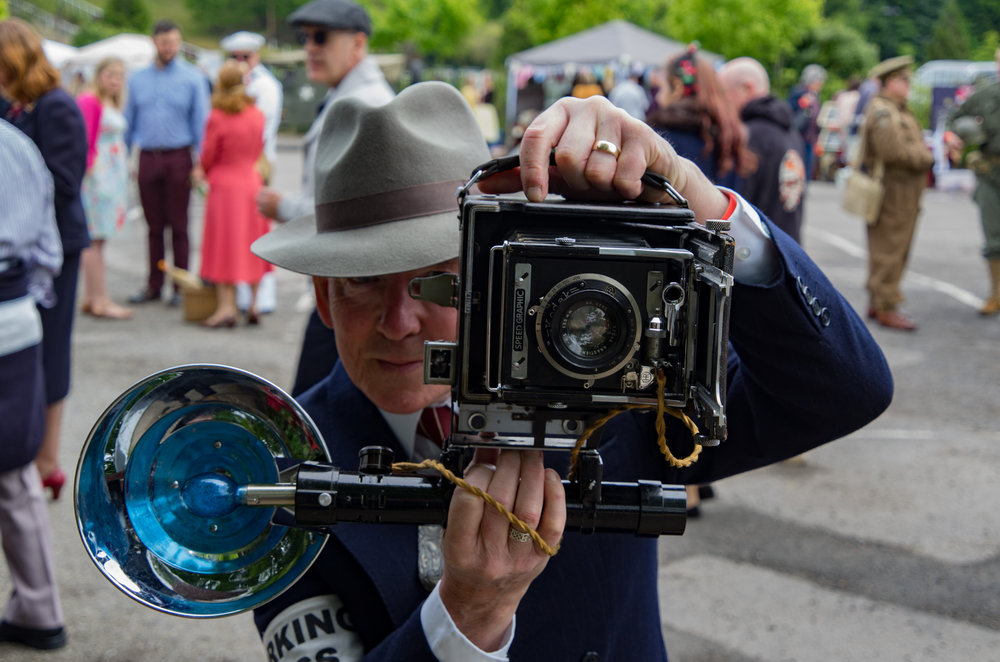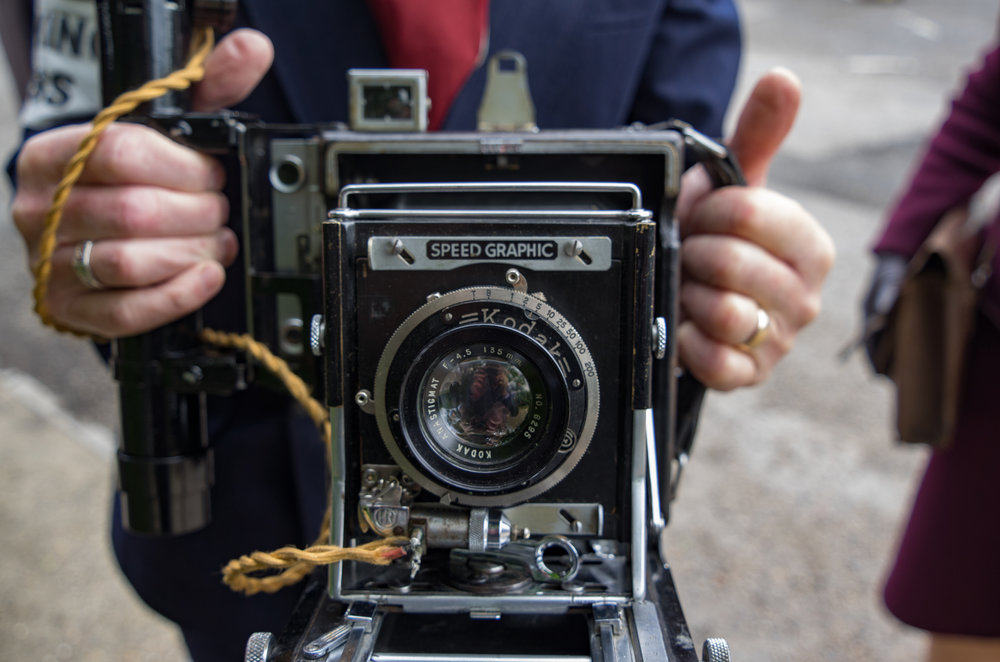
On Saturday I took my new-old Leica T to the annual 1940s Revival meeting at Brooklands Museum in Surrey and got a little bit more than I bargained for. Only last month we carried a fascinating overview of vintage press cameras by an expert on the subject, Bob White. So I was more than surprised to meet a very genuine-looking 1940s press photographer with one of the cameras featured in Bob’s article — the Speed Graphic. He was accompanied by a female reporter, dressed to the nines, who fed him a constant supply of plates from her voluminous handbag.

The pair were going through all the motions of recording this year’s revival event for posterity and I was amazed by the apparent professionalism. “Do you develop the plates yourselves?”, I ventured. I was mildly disappointed to find that it was all for show. It was the same plate that kept reappearing to create the sense of a busy photographer. Still, full marks to the duo for a convincing piece of press theatre.

This year’s 1940s revival was a corker, well attended and with a high proportion of visitors who had entered into the spirit of the event with some fabulous outfits. I’ll be posting more shots later when I return from Berlin where I am doing a quickie commercial photo assignment. From a photographer’s point of view, these “dressing up” events provide a great opportunity for capturing some really unusual period stuff, all the more effective when there is a definite theme as in this instance.
Last year, I remember, I went along with the then-new Leica SL and 24-90 Vario-Elmarit. This year it was a bit of retro for me, too. The T, which I bought a few weeks ago, is now three years old. I carried the 23mm Summicron and the sharp 18-56mm Vario-Elmar. For an event such as this, the zoom is perfect and the 23mm spent most of the day resting in the Billingham. As is the case with the SL’s 24-90, the 18-56mm-TL zoom (equivalent to 28-85mm in full-frame terms) is possibly the only lens you need. I also love the wide-angle 11-23mm TL zoom which, combined with the 18-56mm, makes a really effective travel outfit.
There will be more to come on the 1940s revival and on the Leica T system.
_________________
- Subscribe to Macfilos for free updates on articles as they are published
- Want to make a comment on this article but having problems?

Thanks Mike for your excellent account and photos of the 40’s photographer and his Speed Graphic. I also photographed him in Sandwich Kent a day or so ago and marveled at his agility and authenticity. My shots are on Flickr and I am trying to find out his name and that of his female reporter in order to caption my pictures. Anyway, mine are here: https://flic.kr/s/aHsmDhUe9y
Tony, thanks. This is an old article but I hope someone will see it. I had a long discussion with them and I did get a card. The reporter is his wife as far as I could understand. You may see that my old friend Don Morley, who actually used one of these cameras back in the day, reckons he was holding it all wrong. See the sonnets to the original article. Anyway, it’s fun. I am going to the 1940s day at Brooklands later this month and if I bump into them I will get a card.
Sorry but not very convincing. As a 1950s Press Photographer who genuinely did use Speed Graphics and still has one this picture actually portrays most of what I see so often repeated in so many BBC, ITV and even film period dramas. What you might ask though are the giveaway?
Several actually but THE most obvious being he is looking through the raised flip up sports finder eye piece top center on the camera, yet the picture frame itself which defines what the camera will see (It slides up from the front lens panel) is nowhere to be seen as it is still folded away, meaning this Gent cannot have a clue what would or would not be contained within any of the picture if he were to take any. Sorry must try harder! Don
Good to have your professional eye, Don. You are right, though, this couple were acting out what we normally see in period dramas, with a strong US bias, I suspect. It’s interesting about the viewfinder, though, and it’s something I didn’t think about until reading your comment.
Looking at the pictures with the article reminds me of another Speed Graphic story. When equipped with the flash, the Speed Graphic became a formidable weapon if needed when competing with other photographers in a "scrum". The package made a very convincing persuader to move others out of your way to get "the shot". The other thing photographers used to do was yell "catch" to unsuspecting bystanders when ejecting a spent molten glass flash bulb. It was good for a laugh watching the poor victim deal with the "hot potato"!
The Speed Graphic was what my Dad used as a US Army photographer in immediate Post-War Germany. His job was to document the demilitarization of all the left over war material in Germany after the war. The idea was it was too expensive to bring it all home, and we didn’t want the Soviets to grab it if they invaded Germany. So it had to be destroyed over there. My Dad was part of US Army Ordnance, and was on call 24 hours a day to document this destruction with his 4×5 Speed Graphic. His films were sent off to the Pentagon in Washington so they could follow the progress on what was being done. I have many pictures of 150mm guns and tanks and so on, and my Dad told me they even used tanks to crush crates full of Norden bombsights. They tried this method on one or two and it worked great. Then they lined them up in long rows and tried to drive the tank up on them. It crushed the fist couple, and then the tank just rode along atop the rest with no damage at all! Those packing crates must have been pretty strong. So much for that.
While stationed in Germany, he began the quest to acquire a Leica. Much easier and handier than the Speed Graphic. He finally did get the Leica and that started him using Leica the rest of his life, and me becoming a life long Leica user and enthusiast!
I still have his old Speed Graphic and all of his Leicas.
Great story Bill. I bet the tanks would have rolled right over the Speed Graphic as well. It’s good you still kept everything.
Terrific photos reminded me of book I read on WEEGEE a NYC photog reporter who used speed graphic developed pics back of car, then sold as hot off the press. At some point he worked in London for one of papers think he would appreciate that couple except the male is missing WEEGEE CIGAR!
Yes they did a good act. I’m always amazed at the dedication of revival actors. They really get into the plot. But most take the easy route — military gear, demob suit. This couple thought of something original and it worked. They really stood out.